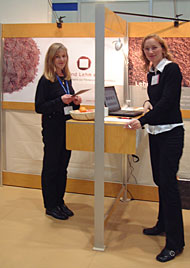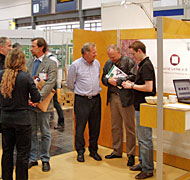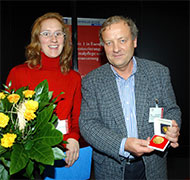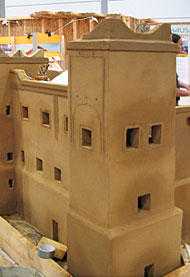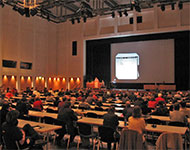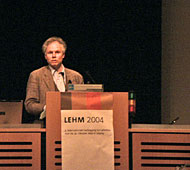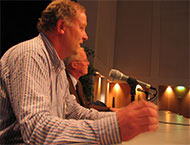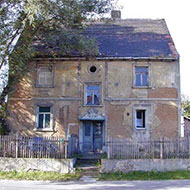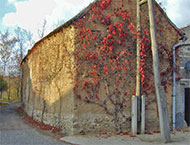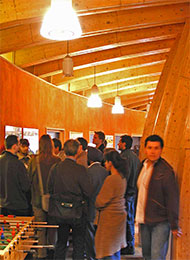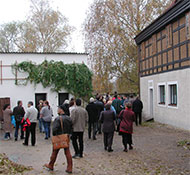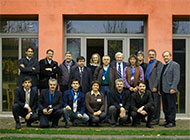| » Deutsch |
|
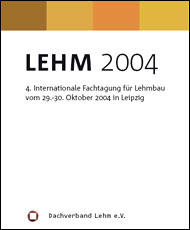 |
The LEHM 2004 – a review of a successful conference!
|
|||||||||||
The LEHM 2004 trade fair
|
The trade fair - earthen building first hand at the denkmal 2004 Beneath the long banner of the Lehm 2004, a 400 m² area of the denkmal 2004 trade fair devoted to building with clay and earth, 16 firms, a publisher and the Dachverband Lehm e.V. exhibited as part of the denkmal 2004 trade fair. In just 4 days more than 15,000 visitors from 39 countries visited the denkmal 2004, many with specific interest in building with earth. The Dachverband Lehm (DVL), present for the first time in their own right, provided not only information about the material and their activities but also a platform for the members to be present and exhibit. In addition to DVL information material and brochures, many members' flyers and brochures were also available on the DVL stand. Information only available up until now on the organisation's homepage was available in print or electronic media. Particularly well-received was the consumer information brochure "Building with Earth" which provides an overview of the material, its properties and use in building. In addition, the Multilingual Terminology Glossary for Building with Earth in German, English, French, Spanish, Italian and Russian languages was also available as a program on CD. For those unable to visit the LEHM 2004, both items can be ordered from the Dachverband Lehm directly at a self-cost of 5 € plus P&P for the consumer information (4 € for 10 or more copies) and 15 € for the Glossary CD. For its services in the development and promotion of earthen building in conservation, the Dachverband Lehm e.V. was honoured with a Gold Medal by the denkmal 2004. The gold medal was awarded during the denkmal 2004 in a ceremony on the 29th October 2004. A central attraction was the building of the 1:10 scale model of the southern Moroccan Kasbah Asslim adjacent to the DVL trade fair stand. Using modern earthen building materials, Manfred Fahnert and guests from Lehmexpress began working on the 25 m² large model at the beginning of the trade fair and a few days later the Kasbah model was erected and plastered complete with decorative window surrounds. The 250 year old Kasbah Asslim in Agdz in Morocco is a Berber fortress made of earth on the edge of the northern Sahara. Over a period of seven years, the artist and earthen builder Manfred Fahnert has worked together with voluntary helpers and students in yearly/twice-yearly expeditions to renovate the Kasbah for the Aid el Caid family, whose livelihood is closely bound with the Kasbah.
|
||||||||||||
|
|||||||||||||
The LEHM 2004 conference
|
The conference - more than 200 participants from all over the world The Congress Center Leipzig (CCL), directly adjacent to the Leipziger Messe, was the venue for the fourth LEHM international conference on building with earth on the 29th and 30th October 2004. Together with ICOMOS, the world heritage council of the UNESCO, the conference aimed to highlight not only that earth has been used as a building material since the beginning of time but that spectacular buildings and constructions have been built over the ages by all manner of cultures and in a variety of climates. Building with earth can be seen all over the world. Many speakers spoke about investigations into and problems associated with the conservation and reconstruction of a variety of world heritage sites made of earth. As an extension of this central theme, and in response to the devastation caused by earthquake in Bam, Iran on the 26th December 2003, several speakers described current activities in the earthquake resistant design of earthen buildings and measures to improve the earthquake resistance of earthen monuments and buildings alike. 26 papers were presented by speakers from Germany, Italy, Belgium, England, Uzbekistan, Kazakhstan, France, the Yemen, Iran, Australia and the USA including leading representatives in the field: the General Secretary of ICOMOS International, Dr. Dinu Bumbaru; Christian Manhart from the World Heritage Department of the UNESCO in Paris, and Alejandro Alva Balderrama from the ICCROM in Rome. Complementing the trade fair a number of speakers also addressed issues of renovation and construction in Europe and profiled new projects which employ earth as a building material. To summarise, the conference focussed on the issues:
The 200 participants came from Germany, Italy, Austria, Switzerland, Sweden, England, Iran, the Lebanon, the Yemen, Mexico, Uzbekistan, Kazakhstan, Portugal, Turkey, Greece, Canada, India, the Czech Republic, Finland, Australia and the USA. All conference papers as well as the poster session summaries are printed in full in German and English in the LEHM 2004 conference proceedings. The proceedings can be ordered from the Dachverband Lehm (Postfach 1172, D-99409 Weimar, Germany; ISBN 3 00 014864 7, 35 €). |
||||||||||||
Parallel Programme
|
Poster session and parallel programme 14 further conference participants presented information in the form of posters exhibited in the foyer of the CCL. Additional film material and slides about building with earth and earthen architecture were shown alongside the conference. A particular highlight were three new hour-long films from the Munich-based company Filmquadrat entitled "Adobe Towns" focussing each on a different city: Yazd in Iran, Djenné in Mali and Shibam in the Yemen. The DDR training films on building with earth put out by the DEFA (former East German Film Federation) were also shown as was an information film on straw-bale building and a slide show about earthen architecture in Morocco. Last but not least, both the DVL and FAL e.V. presented information about their vocational training courses: the "Specialist for Building with Earth" (DVL) and "Clay Plaster and Design" (FAL e.V.) |
||||||||||||
|
|||||||||||||
Field trips
|
Field trips - new and historic building with earth To round off the primarily indoor events in Leipzig, two interesting field trips were organised to buildings in the surrounding region on the 31st October. The first field trip, lead by Dr.-Ing. Christof Ziegert and Dipl.-Ing. Richard Rath, concentrated on historic buildings in the region between Merseburg, Querfurt and Naumburg, approximately 50km west of Leipzig. Buildings have been constructed with earth over many centuries in the region most notably in the mid-19th Century and again briefly after World War II. A number of individual buildings in different locations were visited, including the historic villages of Baumersroda and Steigra whose village centres are mostly made of 2-storey cob and rammed-earth buildings dating back to between 1700 and 1850. Many examples still testify to the fact that monolithic building with earth was used not only by the poor but also for representative rural buildings. It therefore appears natural that after the 2nd World War the legacy of earthen building was revived during a period in which other building materials were scarce. The participants visited a settlement in Brausbedra and the "largest earthen building site of the DDR" in Mücheln. In 1953 more than 98 dwellings were built here as 2-storey rammed-earth constructions. A large variety of building types are present: farmhouses, houses for settlers returning from the former German territories, terraced houses as well as the two storey buildings already mentioned. In many cases the underlying construction is not immediately visible as the buildings were rendered uniformly. Often the construction becomes visible only once the external render has fallen into disrepair or is removed during renovation works. The participants were particularly impressed by the variety and number of monolithic earthen buildings still present in an otherwise 20th Century environment. However, it was also clear to see that many buildings were in a state of at times serious neglect or that renovation measures undertaken were ill-chosen or uninformed.
In Grimma, the Kinder-Lehm-Haus (children's earthen house) provided an excellent example of the symbiosis of old and new. The young family with four children have renovated, converted and extended a former brewery building on the Hohenstädt Manor Estate originally built in 1870. The combination of wood and earth is used throughout in a variety of constellations. The third site in Börtewitz was the building site of a children's nursery being erected using rammed-earth. The emphasis is on the creation of a healthy, natural and pleasant environment for very young children and a direct connection with place. The final leg of the tour visited an old (1795) half-timbered guest house in Canitz which has undergone restoration and conversion. The renovation measures included replacing parts of the external timber frame and replacement of the infill panels with light earth blocks. An additional wall lining of light clay bricks was also erected on the inside to improve the thermal performance of the building. |
||||||||||||
Follow-up workshop
|
Follow-up workshop Several conference participants also took part in a follow-up workshop in Weimar on the 1st and 2nd November organised by the Bauhaus Universität in Weimar and supported by the Dachverband Lehm e.V. The follow-up workshop "Earthquake-resistant Construction and Conservation with local Materials in Central Asia" continues the series of meetings after the devastating earthquake in Bam in December 2003 in which a staggering 27,000 people lost their lives. 25 international experts from Germany, Iran, Uzbekistan, Turkey, the Lebanon, Sweden, the USA and England took part in the workshop and discussed cooperation possibilities between institutes, companies and organisations for earthquake resistant building using locally available building materials. The workshop was opened by Dr. Werner von Trützschler, General Secretary of ICOMOS Germany and was also accompanied by a poster presentation on steel frame construction and earthen fill material. A workshop brochure is planned for 2005. The workshop was supported by earthen building and steel building firms with expertise in building in earthquake-prone regions. |
||||||||||||
| Further information | For further information about both the LEHM 2004 and the follow-up workshop please contact the DVL: Dachverband Lehm e.V. Tel.: +49 (0) 3643-778349 Hannah Schreckenbach and Anke Richter |
